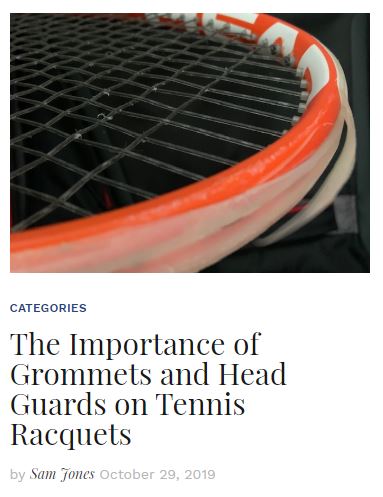Stringing your tennis racquet can be an overwhelming chore, especially if you don’t know where to go or what to look for. Thankfully though, at Tennis Express, we have over 20 USRSA Certified Stringers that are here to help answer all of your stringing questions. Below are some frequently asked questions, that can help you with your game.
1. What tension and/or string is best for me?
This is a loaded question and it will really pertain to several different factors. How often do you play? How often do you break strings? What racquet do you use? What is your swing style? Do you hit with a lot of spin? Manufacturers will often give you suggestions on what tension and strings you should use, but it’s just a starting point. Strings are really meant to enhance your playing abilities. So you want to find a string that works well with your game and can be adjusted to different tensions. Higher string tensions will often result in more control, while lower string tensions will often result in more power. Just remember that the tension and string you use will always affect the way you play. You want to make sure you’re getting the proper effects out of that string, so you can remain confident. The current trend with stiffer strings (polyester, kevlar,etc.) is to string them lower (45-50 pounds), while natural gut or multifilament strings can be strung tighter (55-65 pounds) and maintain solid comfort.

2. Do I need to use the same branded string as my racquet?
NO! Using the same branded string as your racquet is not a written law and is definitely not enforced. Many players use the recommended string(s) from the manufacturer, but it’s not the only answer to find the best string for your game. The only way you will know is if you test many different strings across multiple brands.
3. Why am I having arm or tennis elbow problems?
This is probably due to a combination of stiff strings with a high string tension, and overuse of the elbow area when you play. This is very common among players today because of monofilament co-polyester tennis strings. Monofilament strings are seen on tour as being the best string for control and durability; however, what many players don’t realize is they are very firm and require fast racquet head speed consistently. The first questions to ask yourself if you’re getting tennis elbow problems are: how often am I playing and what type of string/tension did I last string my racquets at? If you’re playing 6 days a week and using RPM Blast 15L strung at 60 lbs, you’re probably not doing yourself any good. The first steps to take are: rest your body, lower your string tension 4-5 pounds, and try a softer string construction. Yes, I know most people want to play like their favorite pros, but it doesn’t do you any good if you’re watching from the sidelines and needing cortisone shots every week.

4. Why did my string break in a weird spot on my racquet?
There could be a couple different factors making your string break in weird spots along your tennis racquet.
- Loose/cracked grommet or head guard. Often players don’t think about the plastic grommets that hold our strings in place and keep them from breaking prematurely. When your head guard and grommet is looking scuffed, cracked or breaking off your frame, then it’s definitely time to replace it.
- Cracked racquet frame. If you have ever thrown your racquet on the ground in frustration or hit something that wasn’t a tennis ball, you might need to check the state of your racquet frame. You’ll be surprised how easily some frames can develop cracks and alter how you can string your racquet the next time around.
- Weak spot in the string. Believe it or not, sometimes you can get weak spots in the string even when its just been sitting around your house for awhile. Outside elements can alter the string’s construction and cause it to loose some of its durability.
Rafael Nadal breaks a string during practice at the 2015 Australian Open (Jan. 13, 2015 – Source: Michael Dodge/Getty Images AsiaPac)
5. When should I restring my tennis racquet?
This will vary from player to player as it depends on the type of abuse you put on your tennis racquet. The general rule of thumb is as follows: How ever often you’re playing a week, is usually how often you should get your racquet restrung during the year. For example if you play 4 times a week, you’re looking to get your racquet restrung at least 3-4 times a year. If you love polyester strings, you should know they lose tension faster and should be restrung more frequently. If you’re going to play tournaments, we suggest restringing before every tournament so you can play you’re best tennis. For league, high school or college teams, we suggest restringing in the beginning of season, and every week after that until season ends to maintain a consistent stringbed.
6. What string is most durable?
The most durable string on the market is monofilament or polyester; however, this comes at a cost. Usually when you string your racquet with polyester it’s going to be very firm and lose tension faster than any other type of string. The best solution for increased durability is to use a solid core synthetic gut. This offers a middle ground between natural gut softness and polyester firmness, but with better toughness and tension maintenance.
7. I need more control or power, what tension/string should I use?
Tension and strings should go hand-in-hand when you’re deciding on the right ones for your game. Whether you’re wanting more control or power from your stringbed, there’s 3 main strategies to choose from.
- Try a thicker gauge size. Just going up in thickness for a string could make the difference for your racquet and help add more control. No need to over think about switching to a different string, and you’ll get something you enjoy hitting with.
- Try a higher tension. Like I said before, higher tension usually results in more control. Just bumping up your tension 4-5 pounds can make the difference between a ball going long and landing 5 feet shorter.
- Try a different string type. Most players believe that switching directly to polyester string is the answer for more control and/or power. This is not true. If you’re using a natural gut or multifilament string, you’re next best solution is actually synthetic gut. And if you’re a current polyester user, you may want to try experimenting with a non-polyester monofilament string. These options give you more control, but without the harshness of a polyester string.
Source – polyfibre.com
8. What are the differences between the gauges?
A gauge is referring to the thickness of the string. Most strings will range from 15g – 20g or 1.05 mm – 1.35 mm. The higher the gauge number on the package, the thinner the string will usually be and vice versa. In example, a 17g would be 1.25 mm and a 16g would be 1.30 mm. Thinner strings tend to provide more power, feel and spin potential, but the thicker string will provide more control and durability. Not every manufacturer has the same thicknesses of string, so always be sure to read the package before purchasing.
9. Why do multifilament strings fray?
Multifilaments are a type of string that’s comprised of numerous individual string filaments being wrapped or braided together into a single strand. As you play, your strings will start to rub against each other and the top layers start to break. The bottom layers will remain intact until you wear them down. The more friction you cause from the strings moving across each other, the quicker the strings will break.
10. What is the best string on the market?
There is no “one best string” that is perfect for everyone to buy. Every player will have a difference in opinion and that is okay. All manufacturers will try to say they have the best strings on the market, but it’s all about what is selling the fastest not what is actually good for players.
Hopefully these questions and answers can help you the next time you’re considering stringing your racquet. Just remember to always test out multiple strings and tensions till you find one that fits your game. Not everyone can play with the same string,— and that is a-okay.
For More:









